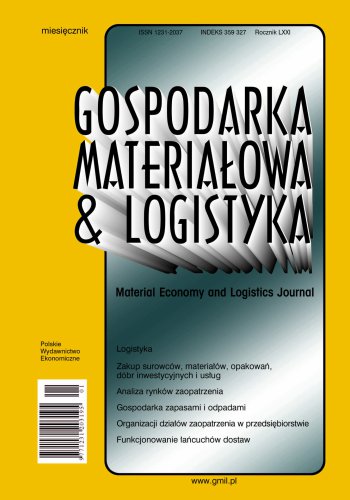Directions of plastic waste management in the era of COVID-19
Directions of plastic waste management in the era of COVID-19
The emergence and rapid worldwide spread of the SARS-CoV-2 virus resulted in increase in the production of plastic waste. The greatest increase in demand was recorded for personal protective equipment due to the fact that many countries have ordered their wearing in public space. The production of disposable food packaging has also increased during the pandemic. Researchers noted that environmental pollution will increase due to improper management of plastic waste and disposal of personal protective equipment (PPE). A rational method of management and processing of plastic waste generated during the SARS-CoV-2 pandemic should be developed in such a way that it does not endanger the environment or human health. This article proposes a method of thermal processing of the above-mentioned waste, namely pyrolysis, which can replace landfilling and incineration. This method allows not only effective neutralization of hazardous waste, but also, which is particularly important, leads to the creation of valuable products.
References
Bibliografia/References
Al-Salem, S. M., Papageorgiou, L. G., Lettieri, P. (2014). Techno-economic assessment of thermo-chemical treatment (TCT) units in the Greater London area. Chemical Engineering Journal, (248), 253–263. https://doi.org/10.1016/j.cej.2014.03.053
Behera, B. C. (2021). Challenges in handling COVID-19 contaminated waste material and its sustainable management mechanism: A Review. Environmental Nanotechnology, Monitoring & Management, (15), 100432. https://doi.org/10.1016/j.enmm.2021.100432
Benson, N. U., Bassey, D. E., Palanisami, T. (2021). COVID pollution: impact of COVID-19 pandemic on global plastic waste footprint. Heliyon, (7), e06343. https://doi.org/10.1016/j.heliyon. 2021.e06343
Benson, N. U., Fred-Ahmadu, O. H., Bassey D. E., Atayero, A. A. (2021). COVID-19 Pandemic and Emerging Plastic-based Personal Protective Equipment Waste Pollution and Management in Africa. Journal of Environmental Chemical Engineering, (9), 105222. https://doi.org/10.1016/j.jece.2021.105222
Capoor, M. R., Parida, A. (2021). Current perspectives of biomedical waste management in context of COVID-19. Indian Journal of Medical Microbiology, 39(2), https://doi.org/10.1016/j.ijmmb.2021.03.003
Dente, S. M. R., Hashimoto, S. (2020). COVID-19: A pandemic with positive and negative outcomes on resource and waste flows and stocks. Resources, Conservation and Recycling, (161), 104979. https://doi.org/10.1016/j.resconrec.2020.104979
Foster, W., Azimov, U., Gauthier-Maradei, P., Molano, L. C., Combrinck, M., Munoz, J., Esteves, J. J., Patino, L. (2021). Waste-to-energy conversion technologies in the UK: Processes and barriers — A review. Renewable and Sustainable Energy Reviews, (135), 110226. https://doi.org/10.1016/j.rser.2020.110226
Haque, M. S., Uddin, S., Sayem, S. M., Mohib, K. M. (2020). Coronavirus disease 2019 (COVID-19) induced waste scenario: A short overview. Journal of Environmental Chemical Engineering, 9(1), 104660. https://doi.org/10.1016/j.jece.2020.104660
Honus, S., Kumagai, S., Fedorko, G., Molnár, V., Yoshioka, T. (2018). Pyrolysis gases produced from individual and mixed PE, PP, PS,
PVC, and PET — Part I: Production and physical properties. Fuel, 221, 346–360. https://doi.org/10.1016/j.fuel.2018.02.074
Ilyas, S., Srivastava, R. R., Kim, H. (2020). Disinfection technology and strategies for COVID-19 hospital and bio-medical waste
management. Science of the Total Environment, 749, 141652. https://doi.org/10.1016/j.scitotenv.2020.141652
Janairo, J. I. B. (2021). Unsustainable plastic consumption associated with online food delivery services in the new normal. Cleaner and Responsible Consumption, 2, 100014. https://doi.org/10.1016/j.clrc.2021.100014
Kampf, G., Todt, D., Pfaender, S., Steinmann, E. (2020). Persistence of coronaviruses on inanimate surfaces and their inactivation with biocidal agents. Journal of Hospital Infection, 104, 246–251. https://doi.org/10.1016/j.jhin.2020.01.022
Køíž, V., Brožová, Z., Přibyl, O., Sýkorová, I. (2008). Possibility of obtaining hydrogen from coal/waste-tyre mixture. Fuel Processing Technology, 89, 1069–1075. https://doi.org/10.1016/j.fuproc.2008.04.011
Liu, H. C., You, J. X., Lu, C., Chen, Y. Z. (2015). Evaluating health-care waste treatment technologies using a hybrid multi-criteria decision making model. Renewable and Sustainable Energy Reviews, 41, 932–942. https://doi.org/10.1016/j.rser.2014.08.061
Di Maria, F., Beccaloni, E., Bonadonna, L., Cini, C., Confalonieri, E., La Rosa, G., Milana, M. R., Testai, E., Scaini, F. (2020). Minimization of spreading of SARS-CoV-2 via household waste produced by subjects affected by COVID-19 or in quarantine. Science of the Total Environment, 743, 140803. https: //doi.org/10.1016/j.scitotenv.2020.140803
Mkhize, N. M., Danon, B., Gryp van der, P., Görgens, J. F. (2017). Condensation of the hot volatiles from waste tyre pyrolysis by quenching. Journal of Analytical and Applied Pyrolysis, 124, 180–185. https://doi.org/10.1016/j.jaap.2017.02.007
Ouyang, S., Xiong, D., Li, Y., Zou, L., Chen, J. (2018). Pyrolysis of scrap tyres pretreated by waste coal tar. Carbon Resources Conversion, 1(3), 218–227. https://doi.org/10.1016/j.crcon.2018.07.003
Purnomo, C. W., Kurniawan, W., Aziz, M. (2021). Technological Review on Thermochemical Conversion of COVID-19-related Medical Wastes. Resources, Conservation and Recycling, 167, 105429. https://doi.org/10.1016/j.resconrec.2021.105429
Rajca, P., Poskart, A., Chrubasik, M., Sajdak, M., Zajemska, M., Skibiński, A., Korombel, A. (2020). Technological and economic aspect of Refuse Derived Fuel pyrolysis. Renewable Energy, 161, 482–494. https://doi.org/10.1016/j.renene.2020.07.104
Sieradzka, M., Rajca, P., Zajemska, M., Mlonka-Mędrala, A., Magdziarz, A. (2020). Prediction of gaseous products from refuse derived fuel pyrolysis using chemical modelling software — Ansys Chemkin-Pro. Journal of Cleaner Production, 248, https://doi.org/0.1016/j.jclepro.2019.119277
Skrzyniarz, M. (2020). Cykl życia odpadów gumowych na przykładzie zużytych opon samochodowych. Gospodarka Materiałowa i Logistyka, (9), 44–53. https://doi.org/10.33226/1231-2037.2020.9.5
Vanapalli, K. R., Sharma, H. B., Ranjan, V. P., Samal, B., Bhattacharya, J., Dubey, B. K., Goel, S. (2021). Challenges and strategies for effective plastic waste management during and post COVID-19 pandemic. Science of the Total Environment, 750, 141514. https://doi.org/10.1016/j.scitotenv.2020.141514
Xu, S., Lai, D., Zeng, X., Zhang, L., Han, Z., Cheng, J., Wu, R., Mašek, O., Xu, G. (2018). Pyrolysis characteristics of waste tire particles in fixed-bed reactor with internals. Carbon Resources Conversion, 1, 228–237. https://doi.org/10.1016/j.crcon.2018.10.001

